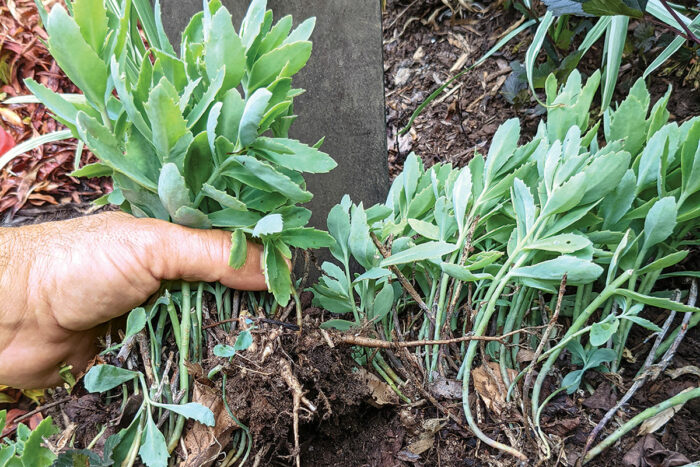
Sedums are easy to care for. They tend to grow naturally in cool, rocky areas, so well-drained soil is ideal. They also grow in open and exposed situations, which means full sun in the garden. In fact, many sedums have become the plants of choice for green roofs. I rarely recommend irrigating or fertilizing sedums unless you are growing them in containers, but here are some tips I do recommend for keeping sedums happy.
Maintenance
Similar to ornamental grasses, sedums need very little maintenance other than cutting back once a year. After flowering, the seed heads of ground-cover types can be removed, but because they will fall apart and disappear over time, this is not necessary. The shrublike autumn types have ornamental seed heads that add interest in winter. They can remain in the garden until early spring. At this time any old stems from the previous season can be cut down as close to the ground as possible, and any old foliage can be cleaned up as well.
If your taller upright plants tend to be too tall for your liking, you can pinch the stem tips in midspring in a method known as the Chelsea Chop. This technique causes the stems to branch and the whole plant to stay shorter and bushier as a result.
Potential problems
The problems that can develop in sedums tend to be associated with moisture. Some sedums will actually rot in wet soil or if a disease like rhizoctonia is present; moist conditions encourage the spread of disease. Thankfully, most varieties are disease resistant; those that are not resistant tend to be the shrublike types.
Propagation
Sedums are one of the easiest plants to divide and multiply. There are three easy ways to do this:
- In the first year, buy one plant; in the following year or two, dig it up and cut it into pieces to get new plants.
- For ground covers, you may not even need to dig up the plant. You can just pull off a few rooted stems to transplant into a new spot.
- Some sedums are so tough and so forgiving that you can actually propagate them by taking a leafy stem cutting without roots and planting it.
There are also sedums that can be grown from seed. The seed is very small, so use a container with fine soil, or sow the seed in a protected spot in the garden. Both cutting and seed sowing are best done in the cool times of the season; mid to late spring or early summer is ideal. In fact, while sedums have succulent foliage and handle hot conditions, they do their growing at the cool times of the year.
More on sedums:
- 10 Stunning Sedums for Dry, Sunny Areas of the Garden
- How to Have Success With Sedums
- Podcast Episode 119: Favorite Sedums
- Colorful Sedums for the Mountain West
Brent Horvath, author of The Plant Lover’s Guide to Sedums, is the president of and head plant breeder at Intrinsic Perennial Gardens, a wholesale nursery in Hebron, Illinois.
Photos: Danielle Sherry




















Comments
Log in or create an account to post a comment.
Sign up Log in